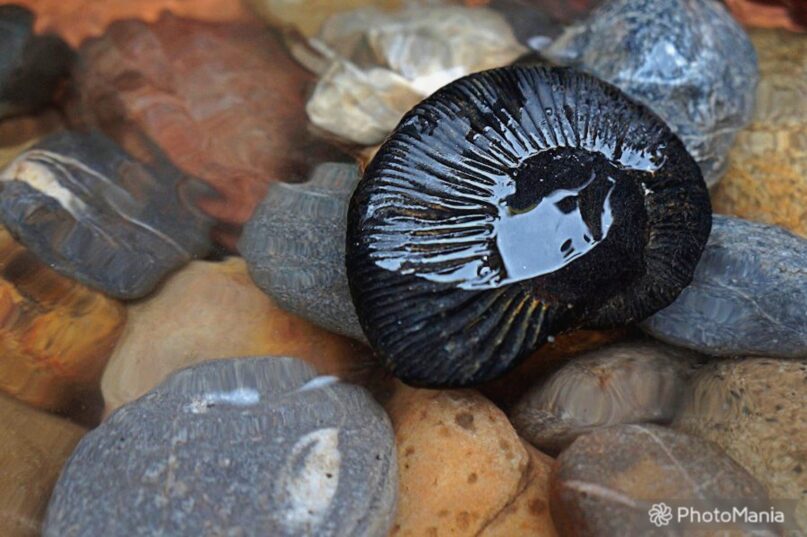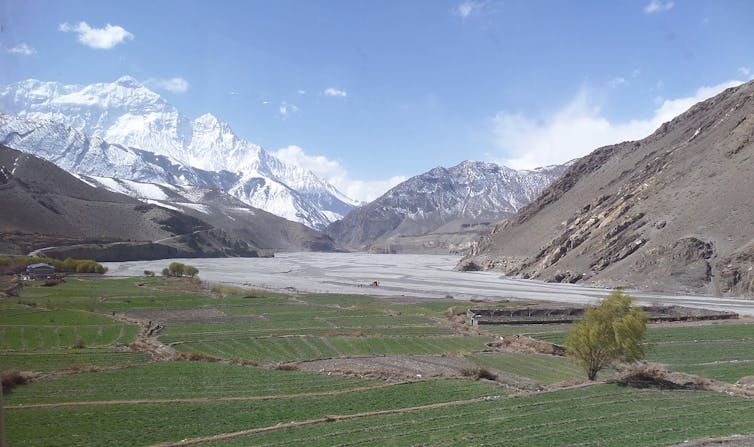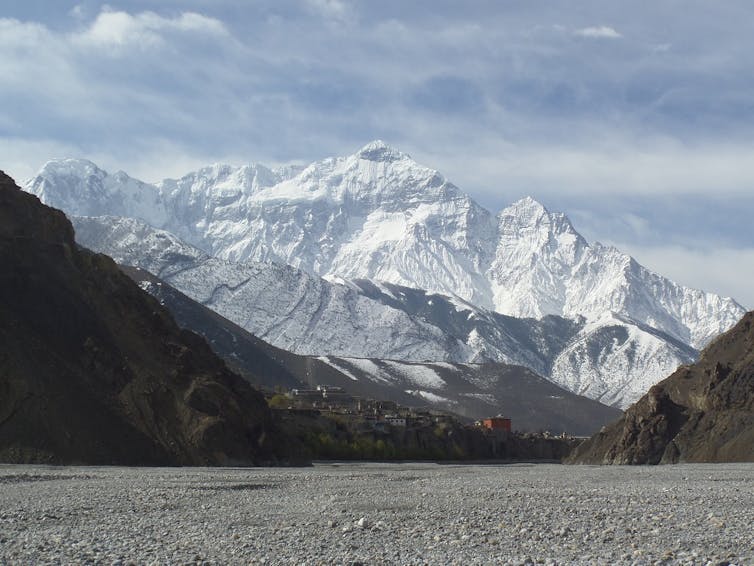Shaligrams, the sacred fossils that have been worshipped by Hindus and Buddhists for over 2,000 years, are becoming rarer because of climate change
Many Hindus, Buddhists and people who follow the shamanic religion of Bon undertake a pilgrimage each year to northern Nepal to look for Shaligrams, believed to be a manifestation of Lord Vishnu.
 CC BY-SA)" >
CC BY-SA)" >(The Conversation) — For more than 2,000 years, Hinduism, Buddhism and the shamanic Himalayan religion of Bon have venerated Shaligrams – ancient fossils of ammonites, a class of extinct sea creatures related to modern squids.
Originating from a single remote region in northern Nepal – the Kali Gandaki River Valley of Mustang – Shaligram stones are viewed primarily as manifestations of the Hindu god Vishnu. Because they are not human-made, but created by the landscape, they are believed to have an intrinsic consciousness of their own. As a result, Shaligrams are kept in homes and in temples, where they are treated as both living gods and active community members.
I went on my first Shaligram pilgrimage in 2015. After arriving at the village of Jomsom in Mustang, I, along with a group of Indian and Nepali pilgrims, started the five-day trek northeast from there to the temple of Muktinath, where the journey culminates.
Making our way through the winding river passage, between 26,000-foot (8,000-meter) mountain peaks, we carefully looked for Shaligrams in the fast-moving water and gathered up any we could reach.
Since then, as an anthropologist, I have documented a wide variety of Shaligram practices while working with devotees in Nepal and in India. In 2020 I wrote the first ethnographic account, “Shaligram Pilgrimage in the Nepal Himalayas,” which demonstrates how popular and important the pilgrimage is among South Asian and the wider global Hindu diasporas.
However, my ongoing work focuses more on how climate change and gravel mining are altering the course of the river, which is endangering the pilgrimage by making it harder to find Shaligrams.
Living fossils
The mythology of Shaligrams is associated with two legends. The first is told in a series of three Hindu scriptures, the Varaha, Padma and Brahmavaivarta Puranas.
In each version of this story, the Hindu god Vishnu, believed to be the supreme creator, is cursed by the goddess Tulsi, who is also called Brinda, because he compromises her chastity. As the story is told, Vishnu disguised himself as her husband Jalandhar so that the god Shiva could kill the demon in a fight. This was because Jalandhar, born from Shiva’s third eye, had previously won a boon from the god Brahma that his wife’s chastity would keep him invincible in any battle.
Angry at the deception, Tulsi transformed herself into a river – the Kali Gandaki – and turned Vishnu into a river stone, a Shaligram. In this way, Vishnu would be continuously born from her, like a child, in repayment for the karmic debt of killing her husband and making her a widow. The landscape of Mustang thus represents the bodies of Tulsi and Vishnu, producing Shaligram stones as divine manifestations from the waters of the Kali Gandaki.
The second legend is told in the Skanda Purana, which explains that Shaligrams are physically created by a type of celestial worm called the vajra-kita – translated as thunderbolt or adamantine worm – which is responsible for carving out the holes and coiled spiral formations that appear on the stones.
As a result, the beliefs around the mythological formation of Shaligrams involve both legends. As part of the first legend, Vishnu takes up residence within a sacred stone that appears in the Kali Gandaki River of Nepal. The story of the second legend is expressed in the carving of that stone by the vajra-kita to give it its uniquely smooth, rounded shape and the characteristic spirals both inside and on the surface.
Rivers and roads
Shaligram pilgrimage takes place high in the Himalayas, usually between April and June and again between late August and November. This helps avoid both the worst of the July monsoon rains and the December snows.

Mount Nilgiri seen from the bed of the Kali Gandaki River.
Holly Walters, CC BY
Mustang, however, is currently divided into the upper or the northern region and the lower or the southern region. In 1950, both Upper and Lower Mustang were closed to travel following China’s annexation of Tibet. But though Lower Mustang was reopened to pilgrimage and trekking in 1992, Upper Mustang remains highly restricted.
This means that the current Shaligram pilgrimage route does not include visiting the Damodar Kund – the glacial lake that produces Shaligrams from the high-altitude fossil beds – because pilgrims are still not allowed to freely cross into Upper Mustang
The village of Kagbeni marks the principal boundary between the two divisions and is also one of the main stops on the Shaligram pilgrimage route. The village sits directly on the banks of the Kali Gandaki and is one of the few areas where pilgrims can reliably find significant numbers of Shaligrams by wading through the river themselves and by watching the river bed for any signs of a black spiral emerging from the sand.
The last destination on the pilgrimage route, at roughly 13,000 feet (4,000 meters), is the temple site of Muktinath, which contains multiple sacred areas of worship for Hindus, Buddhists and followers of Bon. As a place of Hindu worship, Muktinath offers a central shrine to the deity Vishnu as well as 108 water spouts under which pilgrims must pass. The water spouts themselves are hammered directly into the mountain side, which contains a natural aquifer, and provide one last opportunity for practitioners to bathe themselves and their Shaligrams in the waters of Mustang.
As a Bon sanctuary, Muktinath is home to the “Jwala Mai,” or the mother flame, a natural gas vent that produces a continuous flame that burns next to the constant flow of water from the mountain aquifer. Along with the high winds of the Himalayas, representing the element of air, and Shaligrams, representing the element of stone, Jwala Mai contributes to Bon practitioners’ view of Muktinath as a rare place where all of the sacred elements of their religion come together.
As a Buddhist complex, Muktinath is more commonly referred to as “Chumig-Gyatsa,” or the Hundred Waters, and the icon that is worshipped by Hindus as Vishnu is venerated by Buddhists as Avalokiteśvara, the bodhisattva of compassion. In 2016, Muktinath also became home to the largest statue of the Buddha ever built in Nepal.
Climate change and Shaligrams
These traditions then come together to provide a place to ritually welcome all of the new Shaligrams that have just been taken from the water into the lives of the people who venerate them. But Shaligrams are becoming rarer.
Climate change, faster glacial melting, and gravel mining in the Kali Gandaki are changing the course of the river, which means fewer Shaligrams are appearing each year. This is mainly because the Kali Gandaki is fed by meltwater from the Southern Tibetan Plateau. But with the glacier disappearing, the river is becoming smaller and shifting away from the fossil beds that contain the ammonites needed to become Shaligrams.

The Kali Gandaki riverbed near the village of Kagbeni.
Holly Walters, CC BY
For the moment, though, the majority of pilgrims are still able to find at least a few Shaligrams every time they travel to Mustang, but it’s getting harder. Even so, once the new Shaligrams are introduced to worship at Muktinath, it is time for pilgrims to leave Mustang and return home.
For many, this is a bittersweet moment that marks the birth of their new household deities into the family but also means that they will be leaving the beauty of the high Himalayas and the place where deities come to Earth.
But all the pilgrims, me included, look forward to the days when we can return to walk the pilgrimage paths again, hopeful that Shaligrams will still appear.
(Holly Walters, Visiting Lecturer in Anthropology, Wellesley College. The views expressed in this commentary do not necessarily reflect those of Religion News Service.)
No comments:
Post a Comment